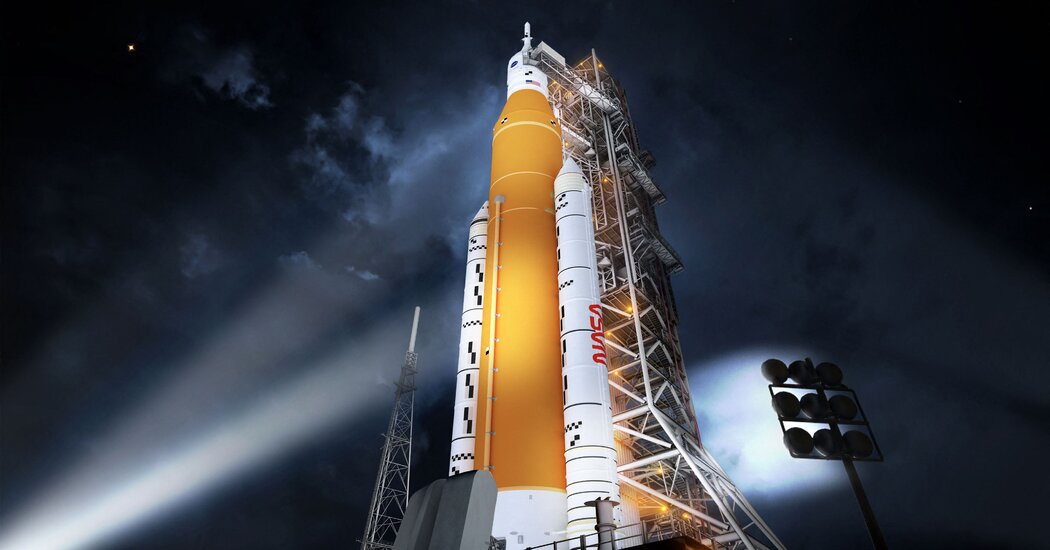
 news
news 
Here’s what may happen in spaceflight in 2022.
Sometime this coming year, two rockets that have never been to space — the NASA Space Launch System and the SpaceX Starship — are expected to lift off.
They’re both very big and about as different as two rockets can be.
The Space Launch System, or S.L.S., is NASA’s interplanetary launch vehicle. It is years behind schedule and billions of dollars over budget. Built by traditional aerospace contractors, each launch costs about $2 billion and each rocket can be used only once. NASA says its Artemis program can’t get astronauts back to the moon without the giant rocket. Its first test flight, with no people aboard, will lift a capsule called Orion around the moon and back to Earth. The launch, known as Artemis 1, is scheduled for March or April.
Starship, by contrast, is being built by SpaceX alone. The fully reusable rocket is central to the vision of Elon Musk, the company’s founder, for sending humans to Mars. A version of Starship is also planned for landing NASA’s astronauts on the lunar surface. The silvery spacecraft’s top half has completed multiple high-altitude test flights that ended in spectacular explosions. It completed a successful landing in one test. Sometime during the year, a Starship prototype with no crew aboard is set to pair with a large reusable booster stage. When the rocket lifts off from a SpaceX launch site in Texas, it will then head to orbit before splashing down off the coast of a Hawaiian island.
If 2021 was the year of missions to Mars, the next year could be dominated by trips to the moon. As many as nine missions from an assortment of countries and private companies could try to orbit or land on the moon.
Five are sponsored by NASA, and some have clearer prospects of occurring on time than others. In addition to the Orion capsule circling the moon and heading back to Earth, a CubeSat, a miniature satellite, called CAPSTONE could be lifted by Rocket Lab from its New Zealand launch site in March. It would study a lunar orbit that could be used by a future NASA and European moon base. Three more missions headed toward the lunar surface are the work of private companies sponsored under NASA’s Commercial Lunar Payload Services program. That effort aims to repeat NASA’s success of relying on companies like SpaceX to carry cargo, and later astronauts, to the International Space Station. Intuitive Machines, a Houston company, may be the first company to attempt the trip.
The rest of the moon’s robotic visitors in 2022 come from other countries. India may try to redo its unsuccessful 2019 lunar landing in the summer. And Russia says it aims to land on the moon for the first time since 1976. A South Korean moon orbiter could lift off on a SpaceX rocket as soon as August. And a Japanese company, ispace, is working on a landing craft for carrying a variety of cargo, including a rover from the United Arab Emirates, to the moon’s surface. Which of these missions sticks to its schedule is up in the very thin lunar air.
Lately, China has kept its word when it says its space program will achieve a certain timeline. So if it says it will finish building the Tiangong space station in orbit in 2022, there’s a good chance that it will.
In 2021, China added its Tianhe space module to low-earth orbit and sent two different crews of astronauts to live there. The second crew will come home sometime in 2022, and perhaps by the middle of the year, a laboratory module, Wentian, may launch to orbit and dock with the Tianhe module. Later in the year, a third piece, the Mengtian lab, could complete the Tiangong space station.
Both Wentian and Mengtian would launch atop China’s largest rocket, the Long March 5B. Last May, that rocket startled many people when it began an out of control re-entry into Earth’s atmosphere, raising the unlikely but not impossible prospect of causing damage and injury when it landed. Even though the rocket splashed down without incident in the Indian Ocean, it remains unclear whether China will change how it is managed. That means twice more in 2022, Earthlings could play the game of “where will it come down?”
NASA has studied numerous asteroids up close, but now it plans to deliberately crash into one. In September, the Double Asteroid Redirection Test is expected to slam into Dimorphos, a small rock that orbits a bigger asteroid, Didymos. Colliding with an asteroid is a potential tactic for planetary defense — if a giant space rock is heading toward Earth, some scientists say that humanity’s best bet is to divert its path so it misses our world. The DART mission would provide data on the effectiveness of this approach.
Other asteroids beckon. Psyche, a large object in the asteroid belt between Mars and Jupiter, appears to be made mostly of iron and other metals. That suggests that in the early history of the solar system, Psyche was the core of an object that failed to form into a planet. A NASA science mission named after the object is planned for launch in the summertime atop a SpaceX Falcon Heavy rocket. Scheduled for arrival in 2026, the spacecraft would provide scientists their first up-close look at this strange metallic world.
24World Media does not take any responsibility of the information you see on this page. The content this page contains is from independent third-party content provider. If you have any concerns regarding the content, please free to write us here: contact@24worldmedia.com